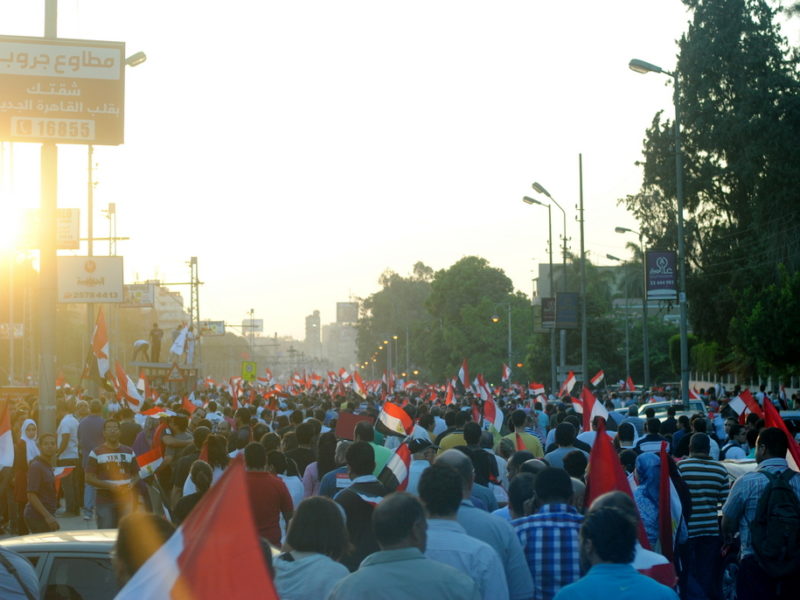Guest post by Killian Clarke
Counterrevolutions have historically received much less attention than revolutions, but the last decade has shown that counterrevolutions remain a powerful—and insidious—force in the world.
In 2013, Egypt’s revolutionary experiment was cut short by a popular counterrevolutionary coup, which elevated General Abdel Fattah el-Sisi to the presidency. In neighboring Sudan, a democratic revolution that had swept aside incumbent autocrat Omar al-Bashir in 2019 was similarly rolled back by a military counterrevolution in October 2021. Only three months later, soldiers in Burkina Faso ousted the civilian president Roch Marc Christian Kaboré, who had been elected following the 2014 Burkinabè uprising.
These counterrevolutions all have something in common: they all occurred in the aftermath of unarmed revolutions, in which masses of ordinary citizens used largely nonviolent tactics like protests, marches, and strikes to force a dictator from power. These similarities, it turns out, are telling.
In a recent article, I show that counterrevolutionary restorations—the return of the old regime following a successful revolution—are much more likely following unarmed revolutions than those involving armed guerilla war. Indeed, the vast majority of successful counterrevolutions in the 20th and 21st centuries have occurred following democratic uprisings like Egypt’s, Sudan’s, and Burkina Faso’s.
Why are these unarmed revolutions so vulnerable? After all, violent armed revolutions are usually deeply threatening to old regime interests, giving counterrevolutionaries plenty of motivation to try to claw back power. There are at least two possible explanations.
The first is that, even though counterrevolutionaries may be desperate to return, violent revolutions usually destroy their capacity to do so. They grind down their armies through prolonged guerilla war, whereas unarmed revolutions leave these armies largely unscathed. In the three cases above, there was minimal security reform following the ousting of the incumbent, forcing civilian revolutionaries to rule in the shadow of a powerful old regime military establishment.
A second explanation focuses on the coercive resources available to revolutionaries. During revolutions waged through insurgency or guerilla war, challengers build up powerful revolutionary armies, like Fidel Castro’s Rebel Army in Cuba or Mao’s Red Army in China. When these revolutionaries seize power, their armies serve as strong bulwarks against counterrevolutionary attacks. The Bay of Pigs invasion in Cuba is a good example: even though that campaign had the backing of the CIA, it quickly ran aground in the face of Castro’s well-fortified revolutionary defenses. In contrast, unarmed revolutionaries rarely build up these types of coercive organizations, leaving them with little means to fend off counterrevolutions.
After looking at the data, I found that the second explanation has more weight than the first one. I break counterrevolution down into two parts— whether a counterrevolution is launched, and then whether it succeeds—and find that armed revolutions significantly lower the likelihood of counterrevolutionary success, but not counterrevolutionary challenges. In other words, reactionaries are just as likely to attempt a restoration following both armed and unarmed revolutions. But they are far less likely to succeed against the armed revolutions, whose loyal cadres can be reliably called up to defend the revolution’s gains.
Unarmed revolutions are increasing around the world, especially in regions like Latin America, Eastern Europe, the Middle East, and sub-Saharan Africa. At the same time, violent revolutions are declining in frequency, particularly those involving long, grueling campaigns that seek transformational impacts on state and society, what some call social revolutions. In one sense, these should be welcome trends, since unarmed revolutions result in far less destruction and have a record of producing more liberal orders. But given their susceptibility to reversal, should we be concerned that we are actually at the threshold of a new era of counterrevolution?
There are certainly reasons for worry. Counterrevolutions are rare events (by my count, there have only been about 25 since 1900), and the fact that there have been so many in recent years does not augur well. Counterrevolutionaries’ prospects have also been bolstered by changes in the international system, with rising powers like Russia, Saudi Arabia, and the United Arab Emirates acting as enthusiastic champions of counterrevolution, particularly against democratic revolutions in their near-abroads. Today’s unarmed revolutions, already facing uphill battles in establishing their rule, with fractious coalitions and a lack of coercive resources, must now also contend with counterrevolutionary forces drawing support from a muscular set of foreign allies.
But though they may struggle to consolidate their gains, unarmed revolutions have a record of establishing more open and democratic regimes than armed ones do. Violent revolutions too often simply replace one form of tyranny with another. The question, then, is how to bolster these fledgling revolutionary democracies and help them to fend off the shadowy forces of counterrevolution.
International support can be crucial. Strong backing from the international community can deter counterrevolutionaries and help new regimes fend off threats. Ultimately, though, much comes down to the actions of revolutionaries themselves—and whether they can keep their coalitions rallied behind the revolutionary cause. Where they can, they are typically able to defeat even powerful counterrevolutions, by relying on the very same tactics of people power and mass protest that brought them success during the revolution itself.
Killian Clarke is an assistant professor at Georgetown University.





